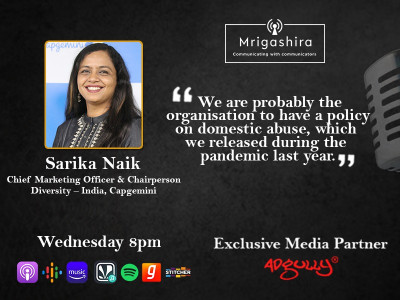How speed, agility, transparency are key pillars of internal communications today
Today, issues like mental, well-being and domestic abuse, which were hitherto not spoken earlier, are being discussed in open forums. In this interview with Mrigashira, Sarika Naik, Chief Marketing Officer & Chairperson, Diversity – India, Capgemini, discusses the challenges and trends in internal communications.
You can listen to the podcast here:
How do you compare between what happened in 2020 and what we are dealing with now?
While the COVID-19 outbreak started in early 2020, and we are still in the throes of the same virus attack. The challenges that we faced last year and the challenges we face today – there is a dramatic difference between them. Last year, our focus was employee safety and getting them quickly to work from home. Then, there was very little information available on things like actions that we need to take to keep our premises clean, what communication to send to our employees. So, the focus was to get employees to safety, enable work from home, and make sure that business continuity happens.
We are proud that 95% of our employees could work from home within weeks of COVID-19 hitting India. We kept the communication channels open with our employees and clients facing a similar situation and wanted to know how we are ensuring business continuity.
In the next phase of communication, employees felt the need to be closer to the organisation. We had to ensure that there is trust and continued engagement. So, there were whole new policies and an entirely new set of employee engagements rolled out.
Today, we are in the middle of the second wave of the virus. More than ever, there is the need for agility, the need for communication around medical health and services. For instance, where can they find an ambulance, medicines, ventilators, ICUs, and so on.
So, the difference is in agility and the nature of the communication.
Does it mean that the speed and the intensity of communications also probably increased?
You know, things that used to take probably three or four days to make sure that the policy is understood and created and launched, the turnaround time is now less than 24 hours. Just to give you an example, with the increasing need for support to employees around oxygen, ventilator beds, etc., we quickly launched information and support on this. We onboarded the necessary tools. All this happened within 24 hours. So clearly, there is a big difference in how communication happens now.
Secondly, the channels of communication have also changed. Last year, we leveraged a lot more media, like podcasts. We believe that the podcast is the channel of the future. On our Capgemini On Air, the leadership talks to employees about the new steps that we are taking regarding employee safety and health. So, not only the speed and agility, transparency is also essential, but I think the channels truly have also changed.
What are some of the lessons learnt from the communication point of view?
The lessons we all have learnt collectively as an industry, as a nation and of course, individual organisations and individuals will stay for many years to come.
Some of these lessons are about topics and issues we were not comfortable speaking about before. For example, mental wellbeing. At Capgemini, mental health, happiness, and wellbeing were always a key pillar. During the pandemic, we realised this pillar is even more critical. We have a helpline, and people can call in if they have any issue. It is entirely confidential.
The other sensitive issue that came to centrestage last year because of COVID-19 is domestic abuse. It is something that people don’t like to talk about. Organisations don’t have a policy on this. We felt the need to launch a policy. I think we are the only organisation to have that. We have defined how to recognise domestic abuse, where people can reach out if they face this unfortunate situation. And what are some of the support areas that the organisation can enable for employees going through this? Before COVID-19, we were focusing on fun and engagement kind of topics. In this time, we realise the importance of such initiatives. And I believe that some of these are going to stay long after COVID-19 is way behind us.
What are some of the new trends and challenges that you see in employee communication?
While emails remain the core way of communicating, new channels have opened up. They become essential today when we are in a virtual world. We have frequent town halls with our leadership; webinars, where we discuss sensitive issues. Here, we can answer the questions in real-time. Besides that, communities like Yammer have seen a massive rise in engagement. We have our internal listening tools for understanding employee sentiment, and we found that communication and trust have stood out in these times as strengths of our organisation. Communication has become the backbone for the organisation to pull all of us together in the same direction.
Today, employees are consuming this communication with a lot more interest and detail. We believe organisations that are communicating very transparently, openly, more consciously, are the ones where the employee engagement and performances have not taken a beating.




Share
Facebook
YouTube
Tweet
Twitter
LinkedIn